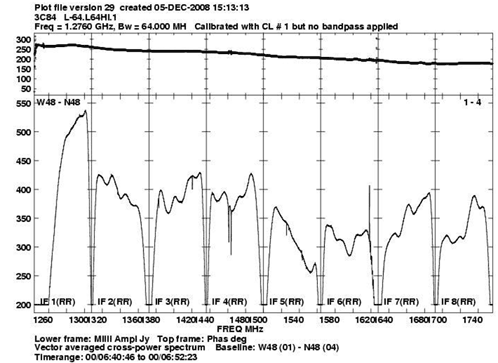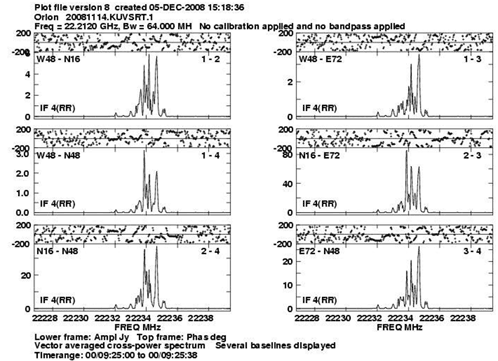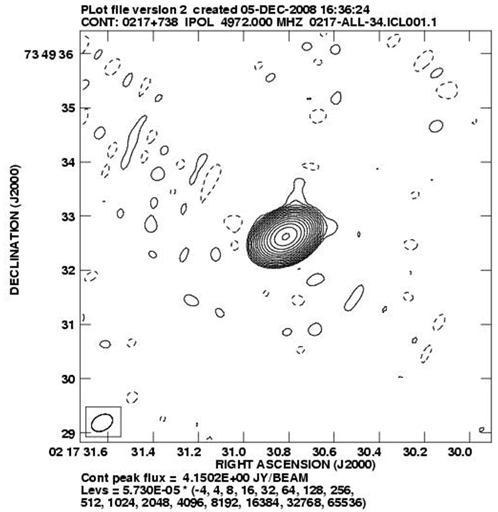M.P. Rupen and the EVLA Project Team
The WIDAR Prototype Correlator for the EVLA has been undergoing tests in New Mexico ahead of ordering the full production hardware. Since September 25 this prototype has had four Station Boards, enabling 4-antenna tests. The tests so far have focused on confirming that the correlator hardware has no major flaws, and the results have been impressive. The correlator has powerful spectral capabilities, and the typical mode we have been testing involves dumping 8192 channels covering 1 GHz (125 kHz/channel) every second for the 6 baselines; the data rate is then about 0.4 MB/s (1.4 GB/hr), about a factor of two greater than the VLA's peak of 200 kB/s. Both AIPS and CASA seem to handle this fine.
Key results so far include the following:
- Robust fringes in both D and A configuration for all bands from 1 to 45 GHz. A sample observation of 3C 84 covering 512 MHz is shown in Fig. 1, while Fig. 2 zooms in on the Orion water masers at 22 GHz.
- The observed phase and delay are consistent over many hours, when switching sources and/or observing frequencies and bands.
- The closure phase is stable over time (many hours at least), and both the closure phase and the rms noise integrate down as expected when averaging over frequency and time. Fig. 3 shows a self-calibrated image of the 4 Jy calibrator J0217+7349, achieving a peak:rms noise dynamic range of 72,800:1.
- Observations of a blank field for 2.3 hours at 8-9 GHz show no correlator artifacts to an rms noise level of 0.05 mJy/beam.
Our efforts with the current WIDAR Prototype Correlator over the next months will focus on cleaning up various software issues that we uncovered while checking out the hardware. This prototype will finally be turned off when the first boards for the final correlator arrive, currently scheduled for late spring 2009.

Figure 1. 3C 84 from 1.244 to 1.756 GHz, at 62.5 kHz resolution (one baseline).There are very strong interference signals from satellites from 1520 to 1630 MHz, which produce the faint lines in that regime; similarly the Albuquerque radar signals occupy IF 2, while (old-style) VLA polarizer suck-outs are clearly seen around 1460 MHz. The absorption lines in IF 3 are due to real HI absorption, from gas in the Milky Way (1420 MHz) and in the host galaxy (1380 MHz). The sharp cutoffs at the subband edges are due to the correlator's digital filters. Note the smooth phase connection within and between the subbands, even near strong radio frequency interference lines. The VLA could cover 6.25 MHz at this spectral resolution.
 Zoom
Zoom

Figure 2: Zooming in on Orion's water masers. This observation used 64 MHz subbands with recirculation to obtain a spectral resolution of 31.25 kHz (0.4 km/s) over 512 MHz (7000 km/s). Here we show 400 channels, or 12.5 MHz — twice the bandwidth available to the current correlator at this spectral resolution, but only 2% of the total bandwidth covered by the EVLA's Prototype Correlator.
 Zoom
Zoom

Figure 3: J0217+7349 observed with the WIDAR Prototype Correlator (4 antennas) at 4.588-5.612 GHz for 2.2 hours. The rms noise level is 0.057 mJy/beam, while the peak is 4.15 Jy.
 Zoom
Zoom

 Zoom
Zoom
